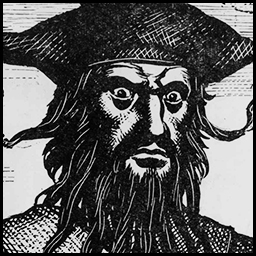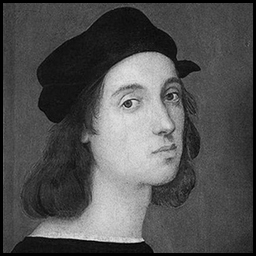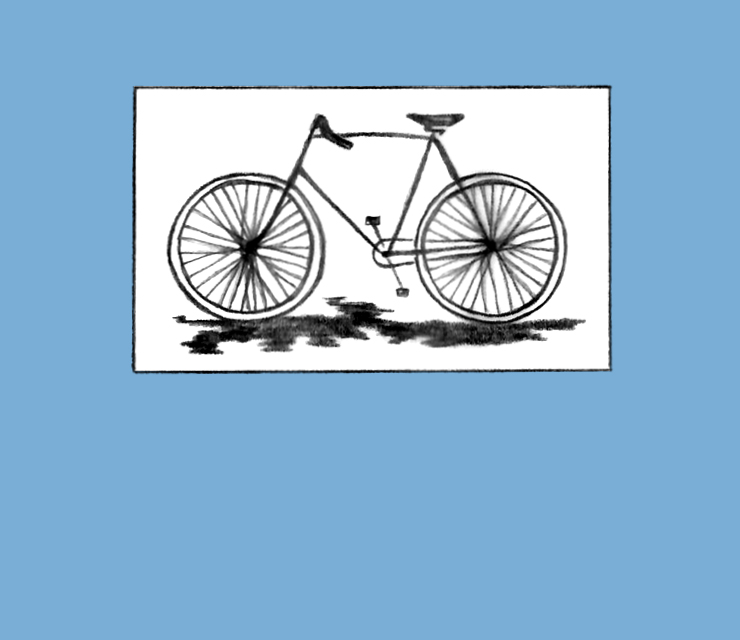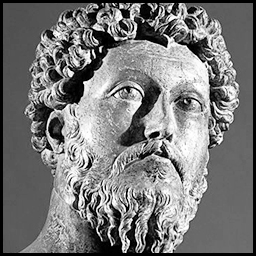
31 — Edward Teach
a.k.a: Blackbeard
Occupation: Pirate
Born: 1680
Died: 1718
Brief Description:
Edward Teach or Blackbeard’s origins are very mysterious for such a well-known pirate. Pirates habitually used fictitious surnames while engaged in piracy so as not to tarnish the family name so it’s unlikely that Teach was his real name but the commonly accepted theory is that he was a commoner born in Bristol during the 1680s, moved to the Caribbean to become a privateer during Queen Anne’s War and later settled in the Bahamian island of New Providence to become a pirate.
Blackbeard’s pirate life was characterized by his imposing appearance and his willingness to use intimidation tactics to get what he wanted. He was known for his long black beard, which he often tied into multiple braids and tucked under his hat, as well as his propensity for wearing multiple pistols and swords at once. He was also known to light fuses in his beard and hat, creating a smoky, intimidating appearance that struck fear into the hearts of his enemies.
Despite his fearsome reputation, there is evidence to suggest that Blackbeard was not as violent as his legend suggests. He is rumored to have never killed a captive or harmed a crew member who surrendered peacefully. Instead, he often preferred to use intimidation tactics rather than violence to get what he wanted.
Blackbeard’s most famous conquest was the capture of the French slave ship La Concorde in 1717, which he converted into his flagship, the Queen Anne’s Revenge. After capturing La Concorde, Blackbeard made a number of modifications to the ship, transforming it into a heavily armed pirate vessel. He added 40 guns to the ship’s arsenal, as well as a crew of over 300 men. The ship was also outfitted with extra masts and rigging, which allowed it to travel at high speeds and maneuver with ease.
At that time, Blackbeard was at the height of his power, with a fleet of several ships and a reputation as one of the most fearsome pirates on the seas. And under his command, the Queen Anne’s Revenge became one of the most feared ships on the seas and was involved in numerous battles and raids.
In May 1718, Blackbeard carried out a daring blockade of Charleston, South Carolina, which was one of the busiest ports in the American colonies. His goal was to extract a ransom from the city and to capture valuable hostages, including the governor. The blockade began on May 24, when Blackbeard sailed his ships into the harbor and demanded that the city surrender. He then ordered his men to set up a blockade at the mouth of the harbor, effectively cutting off all sea traffic to and from the city. Over the course of the next week, Blackbeard and his crew looted several vessels that attempted to leave the harbor, including a ship that was carrying the governor’s personal effects. They also captured several high-ranking officials, including Samuel Wragg, the Speaker of the Commons House of Assembly, and Thomas Smith, the former governor of South Carolina. Despite the chaos and disruption caused by Blackbeard’s blockade, the city of Charleston refused to pay the ransom that he demanded. In the end, Blackbeard sailed his fleet into the harbor and terrified the locals but left with a plunder worth less than two thousand pounds.
Later in June 1718, the Queen Anne’s Revenge ran aground on a sandbar, cracking her main mast and severely damaging many of her timbers beyond repair. Having lost the Queen Anne’s Revenge, Blackbeard accepted a royal pardon and settled down in Bath. But while he seemed to be living an honest life now, he had actually taken piracy to a new level. His men roamed the Carolina rivers taking ships as they always had done.
In response to the growing threat, the governor of Virginia, Alexander Spotswood, dispatched a naval expedition led by Lieutenant Robert Maynard to capture or kill the notorious pirate. The two forces engaged in a fierce battle off the coast of North Carolina, during which Blackbeard was killed. According to some reports, he sustained as many as five gunshot wounds and twenty sword cuts before finally succumbing to his injuries.
Teach’s corpse was thrown into the inlet and his head was suspended from the bowsprit of Maynard’s sloop. On their return to Virginia, Teach’s head was placed on a pole at the entrance to the Chesapeake Bay as a warning to other pirates and a greeting to other ships, and it stood there for several years.
Why he’s on the list:
As you’ve probably noticed already, skill and charisma are two recurring points in my portraits and with Blackbeard, it’s no different. It is believed that Teach was a skilled sailor and tactician, which allowed him to quickly rise through the ranks and become a captain in his own right and his imposing appearance helped him get the intimidation and respect he wanted.
But if Blackbeard is on this list, it’s to represent the pirates from the golden age of piracy as a whole. Not only was he an iconic pirate but he was also friends with many of the other famous pirates of that time. And many of his actions were often carried out for the benefit of piracy in general rather than his own personal gain.
So why do I like pirates?
Simply because they were free, free of a captive world filled with rules.
Pirates also had quite democratic systems in place and members of the crew had equal rights. They were also generally anti-racism and anti-slavery. And they were seen by many as the good guys, despite what the history books make them look like. And that is one of the main reasons why governments and influential figures were constantly afraid of them.
And then of course there’s the romance of the sea, the sword fights and the thrill of great adventures!
Quote Blackbeard
Quote
“It is a blessing for a man to have a hand in determining his own fate.”
— Blackbeard
Image
32 — Raffaello Sanzio da Urbino
a.k.a: Raphael
Occupation: Painter
Born: 1483
Died: 1520
Brief Description:
Raffaello Sanzio was born on April 6, 1483, in Urbino, Italy. He began his artistic career in Urbino as an apprentice to his father, Giovanni Santi, who was a court painter. In 1499, at the age of 17, he moved to Florence to study the works of other Renaissance masters, including Leonardo and Michelangelo.
In 1504, Raphael returned to Urbino, where he established his own workshop and began to receive important commissions. In 1508, he was summoned to Rome by Pope Julius II to decorate the Vatican Palace with frescoes. This was a turning point in Raphael’s career, and he remained in Rome for the rest of his life.
While in Rome, Raphael created some of his most famous works, including “The School of Athens,” “The Sistine Madonna,” and the “Pope Julius II Portrait.” He was also an accomplished architect, and designed several buildings, including the Chigi Chapel in Santa Maria della Pace and the Vatican Loggias.
In his famous book “The Lives of the Most Excellent Painters, Sculptors, and Architects” published in 1550, Giorgio Vasari, an Italian writer, artist, and architect who lived during the same time as Raphael, wrote that Raphael’s paintings were characterized by their “grace, charm, and beauty.” He also praised Raphael’s mastery of composition, line, and color, and described him as a master of portraiture, who had the ability to capture the essence of his subjects.
Vasari also wrote about Raphael’s social skills, describing him as a charming and likable man who was loved and respected by his contemporaries. He also mentions Raphael’s love affairs, and his reputation as a ladies’ man, but praises him for his modest and unassuming nature.
Raphael’s premature death at the age of 37 was a great loss to the art world, but his legacy lives on through his works. He was a visionary artist, who combined technical mastery with a deep understanding of the human form and emotion. He was a true Renaissance man, who excelled in both painting and architecture and who is still considered one of the greatest artists of all time.
Why he’s on the list:
I started liking the Italian Renaissance at a very young age, when I found out that Splinter had named his Ninja Turtles after his four favorite Renaissance artists. And while Michelangelo was my favorite Ninja Turtle, Raphael was my favorite painter. =)
Raphael’s paintings are beautiful. But what I mainly love about them is the sprezzatura that emanates from them, a certain nonchalance or effortless grace in artistic expression. (More on that in a future portrait.)
Raphael had the ability to capture the essence of his subjects in his portraits. He was able to convey the emotions and personality of his subjects with a naturalness that was unique for his time.
He truly was one of the great masters of the Renaissance and as such, he deserves a spot on this list.
Quote Raphael
Quote
“When one is painting one does not think.”
— Raphael
Image
33 — Wilbur and Orville Wright
a.k.a: Will and Orv
Occupation: Inventors
Born: 1867 & 1871
Died: 1912 & 1948
Brief Description:
The Wright brothers, Orville and Wilbur, were American inventors and pioneers of aviation. They are credited with designing and building the world’s first successful airplane, the 1903 Wright Flyer.
The brothers were born in Dayton, Ohio, Orville on August 19, 1871, and Wilbur on April 16, 1867. They were the sons of Milton Wright, a bishop of the United Brethren Church, and Susan Catherine Koerner Wright. Growing up, they were fascinated by mechanics and flight. They built and flew kites and gliders, and read everything they could find about the subject.
In 1892, the Wright brothers opened a bicycle sales and repair shop in Dayton, which they used as a base for their growing interest in flight. They began experimenting with gliders in the late 1800s, and eventually built their own wind tunnel to test wing designs. They studied the works of other aviation pioneers such as George Cayley, Otto Lilienthal, and Octave Chanute, and began to develop their own ideas about how to achieve powered flight.
In 1900, the Wright brothers built and tested their first glider at Kitty Hawk, North Carolina, a location they chose for its steady winds and soft sand dunes. Despite initial setbacks, they continued to improve their designs, and in 1903 they were ready to attempt powered flight. On December 17, 1903, Orville piloted the first flight, which lasted 12 seconds and covered 120 feet. Wilbur piloted the fourth and final flight of the day, which lasted 59 seconds and covered 852 feet.
After their historic flights, the Wright brothers continued to improve their designs and made several more flights in the following years. They eventually opened the Wright Brothers Flying School in Montgomery, Alabama, and began selling airplanes to the military and other customers. They made their first public flight in 1908 at Huffman Prairie, Ohio, and in 1909, they made their first flight in Europe.
The Wright brothers’ contributions to aviation were significant and far-reaching. They developed the three-axis control system, which is still used on airplanes today, and their designs served as the basis for future aircraft. They received numerous accolades and honors during their lifetime, including the French Legion of Honor, and were inducted into the National Aviation Hall of Fame in Dayton, Ohio, in 1973.
Orville Wright died on January 30, 1948, and Wilbur Wright died on May 30, 1912, both in Dayton, Ohio. Their legacy is still celebrated today as they are considered as the fathers of modern aviation. The Wright Brothers’ achievements were not only a technological breakthrough but also a significant moment in human history as it opened up a new era of transportation and communication.
Why they’re on the list:
The Wright brothers were fascinated by flight since their early age when their father brought home a toy helicopter. Wilbur and Orville played with it until it broke and then built their own. Their experience with the toy was the spark of their interest in flying.
At the time, many people and institutions with much higher budgets were also interested in building the first successful airplane. But what gave the Wright brothers an edge was their willingness to build and try out many different prototypes, adjusting and improving them each time.
At a time when flight was generally believed to be impossible, these two unassuming brothers were confident enough and passionate enough to prove to the world that humans could indeed fly. I have a few personal projects of my own that I am passionate about and that I hope to achieve one day and the Wright brothers’ story is an inspiration and an example to follow in the pursuit of these seemingly unattainable goals.
Quote Orville Wright
Quote
“Isn’t it astonishing that all these secrets have been preserved for so many years just so we could discover them!”
— Orville Wright
Image
34 — Marcus Aurelius
a.k.a: Imperator Caesar Marcus Aurelius Antoninus Augustus
Occupation: Emperor
Born: 121
Died: 180
Brief Description:
Marcus Aurelius was born in Rome in 121 AD. He was the son of a Roman aristocrat and was well-educated in philosophy and literature. He became interested in Stoicism, a school of thought that emphasized the importance of living in accordance with reason and virtue.
As a young man, Marcus became close friends with the future emperor Antoninus Pius, and he later married Antoninus’ daughter, Faustina. When Antoninus became emperor in 138 AD, he appointed Marcus as his co-ruler, and upon Antoninus’ death in 161 AD, Marcus became the sole ruler of the Roman Empire.
Marcus Aurelius is best known for his role in leading the Roman Empire during a time of political and military turmoil. During his reign, the empire was threatened by invasions from barbarian tribes and was also plagued by natural disasters, including a series of devastating plagues. Despite these challenges, he remained committed to his philosophical beliefs and sought to apply them to the governance of the empire. He was known for his fair and just rule, and he worked to improve the lives of his subjects by building public works, such as aqueducts and roads, and by establishing charitable institutions.
In addition to his political accomplishments, Marcus Aurelius is also known for his writings, which include the famous “Meditations,” a series of philosophical reflections on the Stoic way of life. In these writings, Aurelius reflects on his own experiences and struggles and offers wisdom and guidance on how to live a virtuous life.
Marcus Aurelius is remembered as a wise and just ruler who was deeply committed to living a virtuous life. His philosophy has had a lasting influence on Western thought and continues to be studied and admired to this day. He is often considered one of the greatest philosophers in history and is revered as a symbol of courage, wisdom, and integrity.
Why he’s on the list:
I could talk about Marcus Aurelius’ virtues or his character or some of his achievements or go in depth into some of his thoughts from Meditations. And I do like the Stoic philosophy in general. But none of those are the real reason he’s on my list.
When Marcus Aurelius wrote his Meditations, it didn’t have a title (at least not that we know of). It probably wasn’t even meant to be published and was later simply referred to as Marcus’ writings to himself.
Marcus likely didn’t care about posthumous fame either. As he says: “People out for posthumous fame forget that the generations to come will be the same annoying people they know now. And just as mortal. What does it matter to you if they say x about you, or think y?
This is similar to my list of portraits. Even though I am writing my portraits publicly, I’m writing them for myself as a form of introspection. If they’re public, it’s only because my readers give me the motivation to actually write them down instead of keeping them as mere thoughts and for that, thank you. =)
Quote Marcus Aurelius
Quote
“Is your cucumber bitter? Throw it away.
— Marcus Aurelius
Are there briars in your path? Turn aside.
That is enough.”






